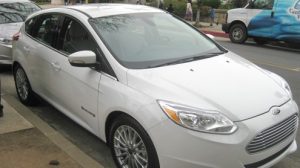Driving on Sunshine: Electric Ford Focus kicks off tour in Santa Barbara
By Julian Moore on April 27, 2012
A Santa Barbara-based environmental group tapped the debut of the first all-electric Ford Focus to draw attention to its plan to install electric car chargers up and down the Highway 101 corridor in the Tri-Counties.
The Community Environmental Council’s Plug-In Central Coast project would add dozens of public charging stations around Santa Barbara and elsewhere to serve the early adopters of electric vehicles, some of which reduce greenhouse gas emissions by 75 percent compared to gas-powered vehicles.
The group received more than half a million dollars from the state and federal governments earlier this year to build stations that would support fully electric vehicles for thousands of residents. In late April, the Community Environmental Council, or CEC, put on two events to promote its project and encourage buyer confidence in electric vehicles.
The nonprofit teamed with Ford to host test drives of its new fully electric Focus and Escape, to be released later this year. The Santa Barbara rides kicked off an extensive U.S. tour for the new vehicle.
Here’s a closer look at both events and the effort to install charging stations.
Earth Day
At Santa Barbara’s Earth Day festival on April 21, as many as 923 festival-goers test drove a salvo of upgraded or unreleased electric vehicles from manufacturers including Ford, Nissan and Chevrolet.
More than 50 stalls occupied a block of Santa Barbara Street, featuring everything from factory-minted electric cars to charging installations that consumers can install at home. Plug-In Central Coast director Michael Chiacos said he is excited about Santa Barbara’s prospects in the electric car market.
“In a matter of years, Santa Barbara and the Central Coast can be driving on sunshine,” he said. “The common theme of this event, is that there are more and more fuel efficient options entering the market and we want people to become comfortable with a reliable electric vehicle.”
Car buyers can also beat the price tag on many electric vehicles by tapping overlapping tax breaks. Chiacos said that while the new Nissan Leaf is advertised at $35,000, a $7,500 federal rebate for California residents combined with a $2,500 rebate from Sacramento can bring the total down to $25,000, less than the average $28,000 for all vehicles sold in the United States.
“The time for getting fuels from hell is over,” Chaicos said, “we’re looking to get our energy from heaven.”
Focus on Ford
At an April 25 event co-hosted by Ford and the CEC, the manufacturer’s electric vehicle program supervisor Stefan Pototschnik unveiled a plan to connect with a number of companies to ease consumer transition to electric vehicles.
By purchasing a Ford electric vehicle, Pototschnik said, consumers can have BestBuy install Leviton electric chargers in their homes, and can receive a reduced rate on installation of Sunpower solar panels on their roofs to streamline home charging. With the solar panels, drivers of the electric vehicles can get 12,000 miles per year, saving $9,700 when gas is $4 per gallon.
The Ford Focus electric, set to be released in fall of 2012, can go up to 110 miles on a full battery before charging. “Electric cars have come a long way in their ability to satisfy customer needs in power,” says Pototschnik, “we think this new platform can preserve the driving experience and get drivers where they need to go.”
In 2011, Southern California Edison directed a survey of 183 cities in California that cited Santa Barbara as the fourth most viable “early-adopter” market for electric vehicles in the state. That number, Chiacos said, explains why the CEC received a total of $250,000 in grants from the state and federal governments.
In late 2011, the CEC cooperated with environmental commissions from five regions in California and requested a bid for $1 million in funding from the U.S. Department of Energy.
The Central Coast group, which included the CEC, extracted $50,000 from the statewide pot and has begun spending on projects such as the Clipper Creek program, which aims to install free public charging stations in Santa Barbara.
“Our hope is that people commuting from Ventura to Santa Barbara or Santa Barbara to San Luis Obispo will feel comfortable knowing they can get to work and back without thinking about their battery,” Chiacos said.
The CEC has begun targeting local hotels to adopt an electric vehicle infrastructure, in addition to the existing free charging stations at the Granada parking garage and the Botanical Gardens.












